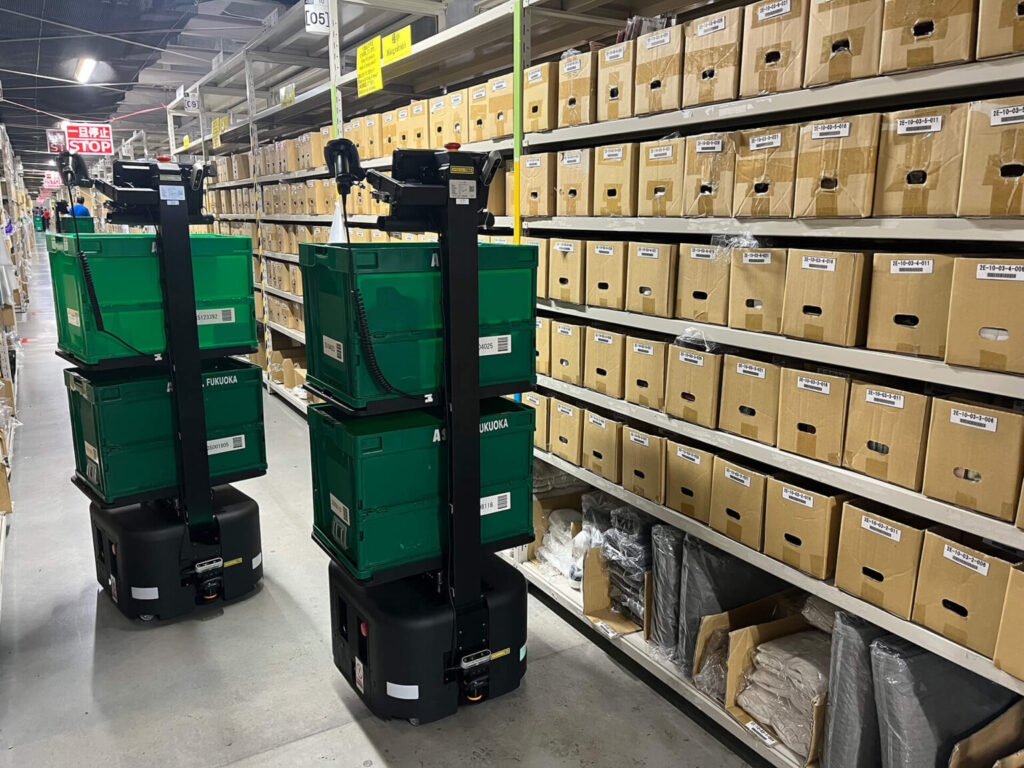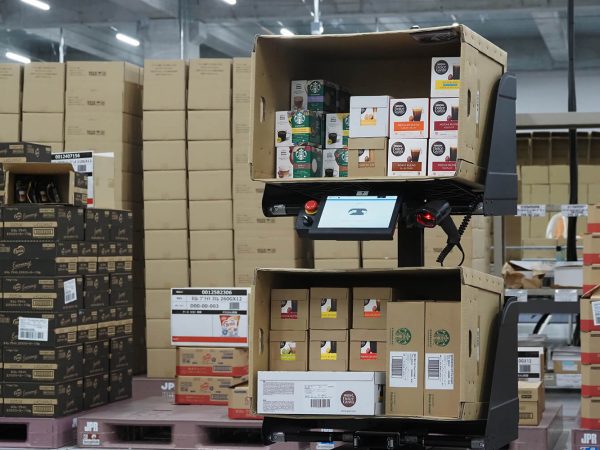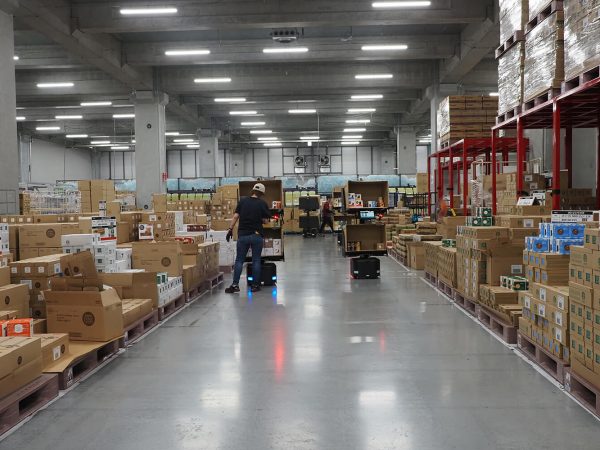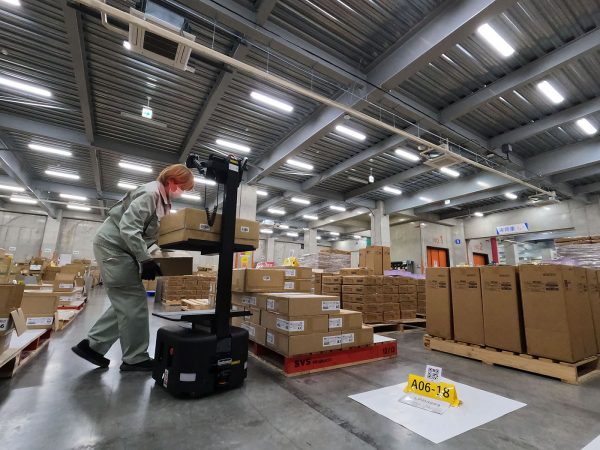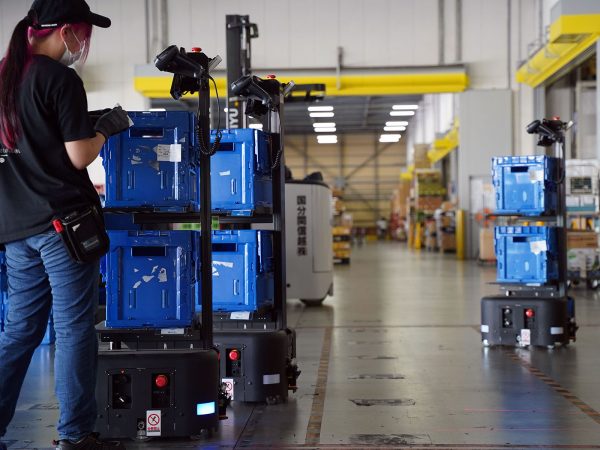Doubled productivity through meticulous planning and on-site optimization!
Practical collaboration with AMR without large-scale construction (Part 2)
For companies seeking to improve their logistics warehouse operations by implementing collaborative robots, gaining insights from businesses that have already implemented them can be highly beneficial. In this article, we will provide valuable insights into the reality of AMR implementation, featuring interviews and case studies on the implementation of Rapyuta AMR.

ASKUL Corporation
ASKUL Value Center Hidaka (AVC Hidaka)
Industry: In-house EC
Number of Units installed: 34
AMR Operation Date: April 2022 –
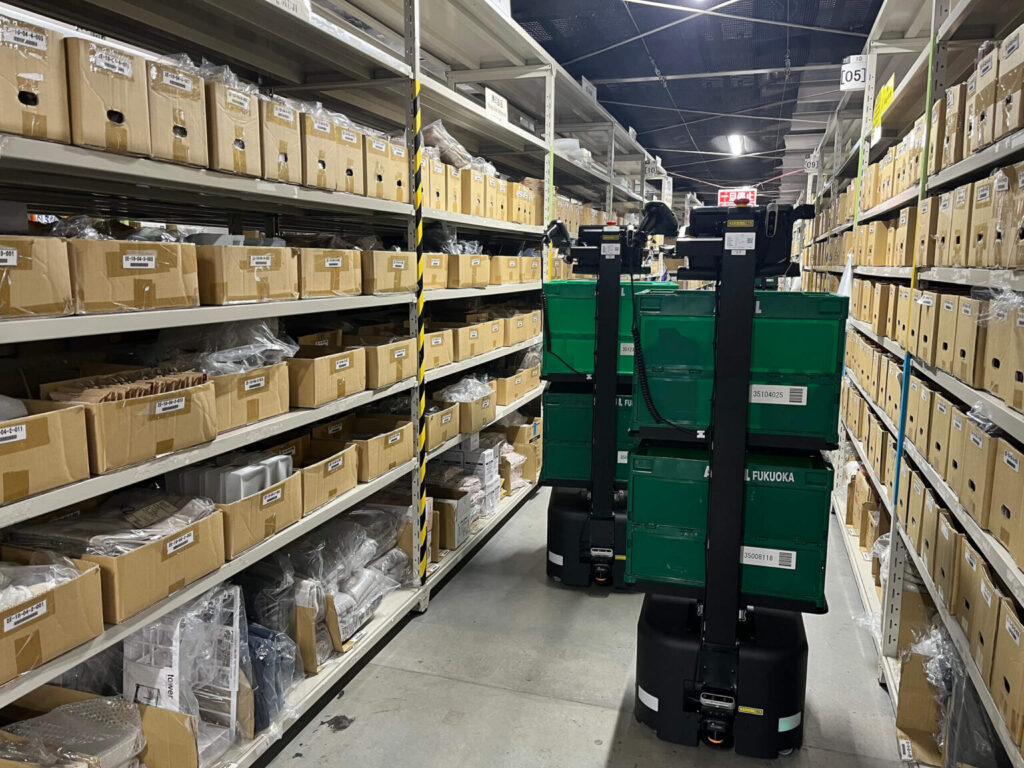
The company we’re featuring in this case study is Askul Corporation, which is involved in both business-to-business and business-to-consumer e-commerce. The company introduced 34 Rapyuta PA-AMRs into a 2314-square-meter area at the Askul Value Center Hidaka (AVC Hidaka) in Saitama prefecture, which serves as the main base for its consumer e-commerce site, LOHACO. They started full-scale operation in spring 2022, after considering the use of AMRs from 2020. Through meticulous simulation and requirement refinement during this period, the collaboration between the site and AMRs fit seamlessly from the beginning of the operation. Just over four months after implementation, they achieved high performance that surpassed the simulation conducted before the introduction.
In the second part of the interview, we discuss the journey of implementing the Rapyuta PA-AMR from the decision-making process to its deployment in the warehouse, and the numerous improvements made on-site that led to the realization of exceptional performance beyond expectations.
Q. What were your honest thoughts about Rapyuta PA-AMR during the pre-introduction simulation phase?
Since Rapyuta PA-AMR had mainly been implemented in smaller to mid-sized warehouses, we were uncertain whether it could deliver similar productivity gains in our larger warehouse at ASKUL.
Therefore, we conducted a thorough preliminary simulation. However, since human movements cannot be replicated in simulations, we factored in anticipated human movements based on previous implementation experiences to estimate the expected productivity levels. Based on this performance projection, Rapyuta proposed a ‘productivity-based pricing model’ that guaranteed minimum cost-effectiveness. This allowed us to ensure that the implementation costs were justifiable. Thanks to this, we were able to achieve a level of return on investment that met our standards.
Q. How much did you have to change or adjust locations when implementing AMR?
Due to the limitations of our environment, we could not make major changes to the location of items or equipment. However, based on simulations, we made minor adjustments such as rearranging the rack layout and expanding the unloading area for containers. We also ensured that there was enough space for the robots to move around. Fortunately, we had conducted prior integration testing, which allowed for seamless data integration with the existing WMS without any major issues. Overall, there was no significant need for location changes or adjustments during the implementation of AMR.
Q. How was the implementation received on the actual site?
Compared to the conventional picking method, the fact that the picker’s hands are free was well-received. Also, many of the pickers are women who, in the past, had to lift heavy containers and put them on the conveyor themselves in the unloading area.
With the introduction of AMR, we were able to completely divide the workload by assigning staff specializing in unloading to the areas for lifting and unloading heavy containers so that the pickers could concentrate on picking.
This was also made possible by simulation, which allowed us to predict in advance how many containers would be lifted and lowered. We found that it was more efficient to have a dedicated person in charge at the appropriate locations.
Regarding the picker’s walking distance, although the total distance may not have changed, the density of picking has increased, resulting in higher productivity. Also, AMR directs the picker to the nearest place to go next, so they can move more efficiently. The image is that the walking distance between picks has been reduced.
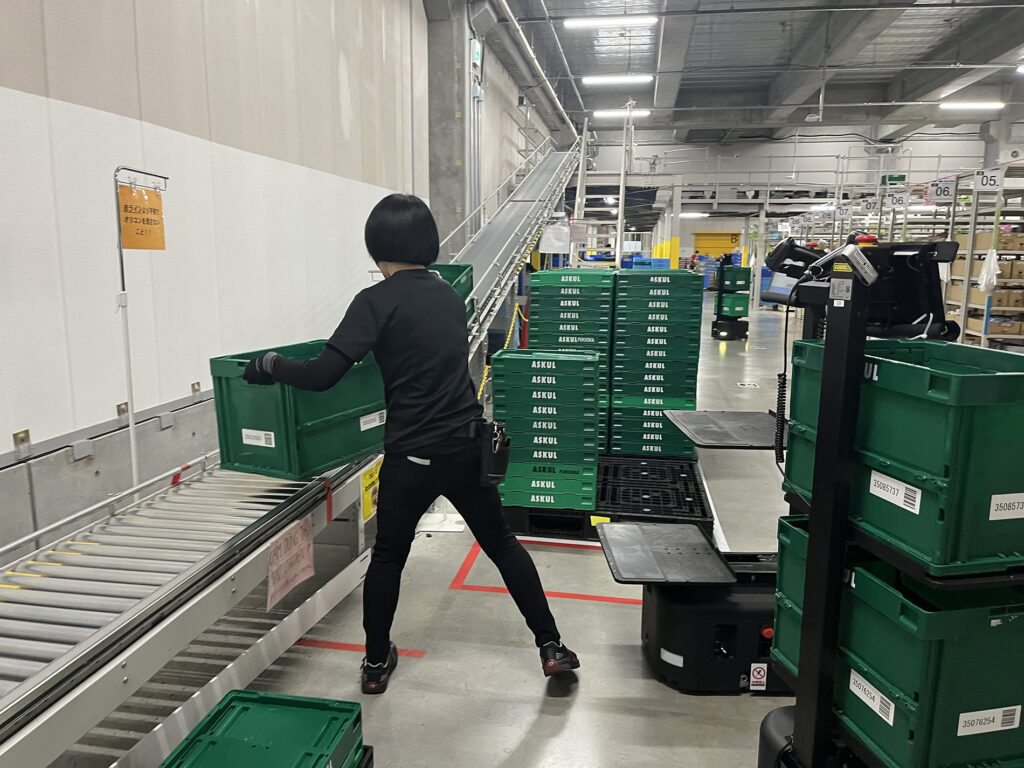
Keypoint: Flexible on-site operations make AMR easier to move, which drastically reduces time loss!
Q. How was training for on-site staff conducted?
First, Rapyuta conducted two “Key User Training” sessions where they introduced the concept of AMR and provided an overview of the actual work process to the management members and the main staff. However, this alone did not cover all the staff members, so we provided an opportunity for all the staff members to experience AMR through on-the-job training (OJT) before the actual operation. The OJT lasted for about ten days, starting with five units and gradually increasing the number of units to ten. We also gradually increased the training time, starting with only two hours in the morning.
Q. Are there any unique measures that are employed in the operation?
During times of congestion, we utilize the “Mark as reached” button to prevent idle time. Additionally, in cases where an AMR is experiencing difficulty due to congestion, our staff on-site is trained to be flexible and able to use the “Mark as reached” button and “manual mode” to maintain productivity even during congestion.
We also noticed that there was a tendency for AMRs to get stuck while moving between two zones, causing pickers to wait at the next designated location while the AMR was still on its way.
To solve this issue, we consulted with the Rapyuta team and later set up traffic rules similar to one-way streets to alleviate congestion. This helped AMRs move smoothly between zones, reducing wait times and ultimately increasing efficiency.
Q. How does the productivity after the introduction of AMRs compare to the pre-simulation results?
We have continuously made adjustments such as avoiding congestion and modifying maps since the start of the implementation. As a result, the productivity levels we initially projected have been largely achieved, almost in line with our expectations. This has been accomplished within four months of full-scale operation.
Q. What kind of support did you receive from Rapyuta?
During the initial stages of operation, there were a few instances where the robots stopped due to errors. To address this, we had the Rapyuta team on-site for about two months until the error rate decreased to a certain level. The fact that they were able to support us even on weekends was greatly appreciated since our facility operates 365 days a year. Now that the number of errors has reduced, the frequency of their onsite support decreased to once a week, but it is still a huge relief to know that we can always count on them for immediate support when necessary.
Q. If there are any benefits or drawbacks that you have experienced during actual operation, please let us know.
We currently do not have log data on the waiting times of the robots, but we hope that Rapyuta can provide us with such data that can only be obtained on their end in the future. It would be great if they could analyze the logs and propose improvements based on the data.
As for hardware, it would be great if we could automate the process of putting containers onto the conveyor, which is currently done manually. Although it may sound like a dream come true, it would be fantastic to see this process automated in the future.
Q. Can you provide three points on what makes an ideal environment for AMRs to operate effectively in a warehouse, based on your experience with the implementation of AMRs?
Based on my experience, I believe that the following three factors create an ideal environment for the effective deployment of AMRs:
- Warehouses that rely on a large number of staff for operations.
- Warehouses that cannot easily change their layout or material handling system.
- Warehouses that handle products small enough to put in a container with one hand.
Overall, I believe that warehouses meeting these conditions can benefit from the implementation of AMRs, resulting in improved efficiency and productivity.
Q. Is your company considering expanding the use of AMRs to other sites in the future?
We would like to consider introducing AMRs to other warehouses where picking is done with carts and handheld devices, like AVC Hidaka. However, each site has its own system and picking method. Some sites require careful consideration for operational improvements, such as those where containers are relayed across different areas. Additionally, some sites have narrow aisle widths, which may necessitate a complete layout overhaul to accommodate AMRs.
Other teams have visited AVC Hidaka and expressed interest in adopting AMRs, so we are considering it positively for future expansion to other sites.
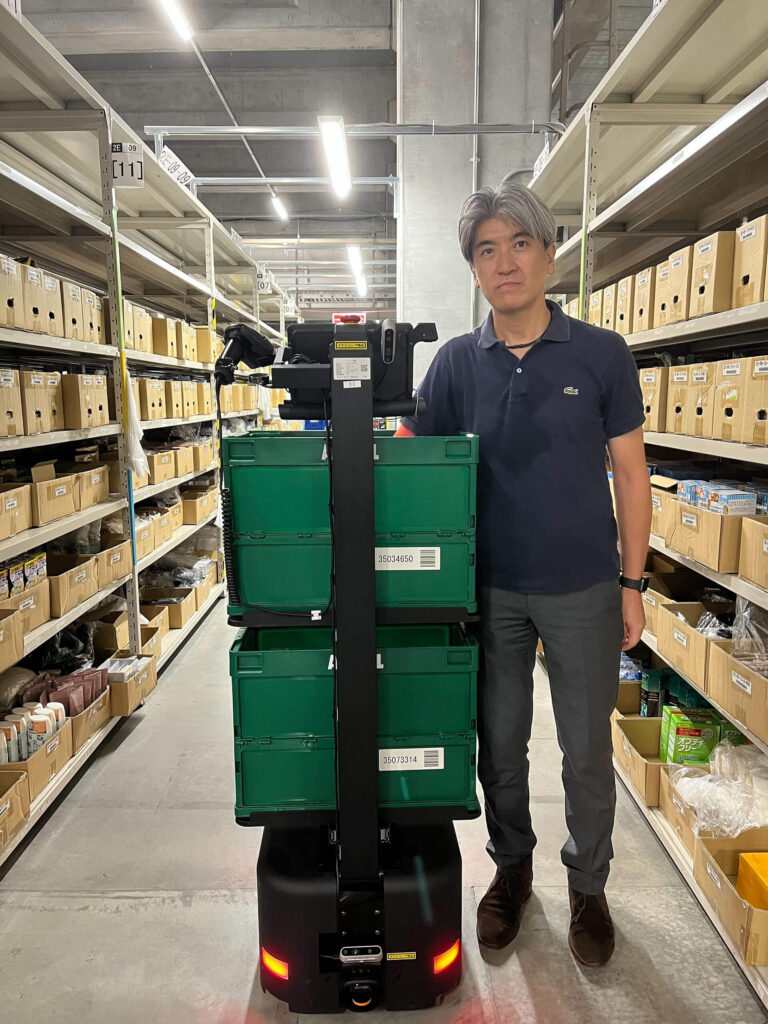
<Summary of Part 2>
Introducing AMRs is just the starting point for resolving challenges. After implementation, closely observing the operations can help identify new challenges, and through creative measures, ASKUL was able to achieve about twice the productivity in a short period. Rapyuta Robotics will continue to support our customers in achieving their goals by having our team work closely with their teams on-site, performing precise adjustments to the AMR system.
